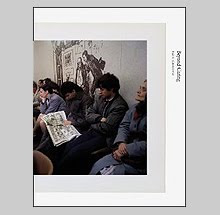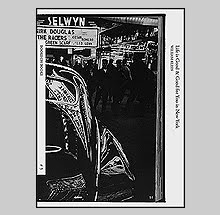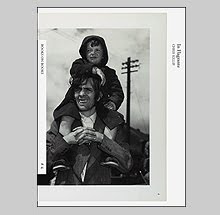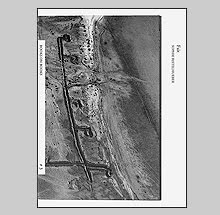Broken Line by Olaf Otto Becker
Early forays into photography explored uncharted lands and gave image to the exotic. This altered the way we thought about the world and made it comprehendible and less abstract. Maps provided an early start but were often as mysterious and misleading as they were informative.
Now satellite photos map detail that even in this day and age seems almost frightening. On Google Maps I can locate the rooftops of the youth hostels where I stayed in Paraganj,
Our understanding of what the world looks like is subject to new imagery to refresh our mental picture. That “picture” is locked into our memory until a new image comes along and throws you a curve ball. Less and less of the world remains outside of our ability to mentally picture and catalog. Funny enough, like pixels that interpolate to their closest neighbor, areas of the world where I do not have a mental image handy become reduced to vast fields of monotone color. These mental images often do not even get us into the ballpark to visualizing the landscape. Being able to view the abstract images of satellite photos is not enough either, photographers need to descend to ground level and seize it with and film or pixel.
This is where adventure and photography intertwine when exploring rarely traveled territories. When Frank Hurley was hired onto the Shackleton expedition’s attempt to cross
The new book Broken Line published by Hatje Cantz late last year brings together 73 of his large format photographs in an extremely elegant presentation.
We do not often see images from these environs because it is a dangerous undertaking to make them. This is an inhospitable landscape where there are few inhabitants and vast distances between them should one need help. In fact, much of this landscape seems untouched until you remember that this is one of the locations mentioned while arguing a point about global warming. Because of that contemporary debate, these photographs take on the additional baggage from the politics of the time in which they were made.
Still, it is the monumental and expansive views that Becker offers that prod us into thinking of periods of history when man did not tread on earth. There is an unsettling stillness to these photographs as if the world has just quieted after a major calamity. Early on in the book, the sequence takes through images of fog-enshrouded icebergs where the landscape seems newly altered with its razor sharp edges and tall icy spires. Chunks of ice shaken loose from cliff faces float on the ocean surface as if evidence of violence.
There are two types of images in this book; ones that feel dangerous and others that give a false sense of security. That security has to do with land and water. When Becker sets his tripod on the floor of his inflatable craft and looks out over the water, we understand that we still in danger, that the unsteady landscape is in control of our fate. While the view from his camera is planted on terra firma, we have the sense that we have some how gained the upper hand (mostly, I think because of the confidence we have with our legs as being more adept to carry us away from danger rather than our arms and upper body). As odd as that might sound, there are few of Frank Hurley’s photographs from the Endurance voyage that give that additional twinge of danger similar to what I feel here even though that story is one of the participants being in a constant life threatening situation.
Occasionally, Becker finds a remote outpost where the evidence of a populace can be seen but in no image does a human being appear. They have recently abandoned their homes and even left the dead sled dog hanging by a rope from a high porch as if their rescue ship finally arrived and left in haste. Their belongings are strewn around the yard without regard for unsightliness like so many cars rusting on cinder blocks in poor rural areas of the U
Becker’s 8X10 camera records it all with lavish detail and a muted palette punctuated by unreal pastel pinks, greens and blues. His wide angle lens, aimed at the horizon, takes in expansive space that recedes off until icebergs or other earthly obstructions pleasantly obscure our view.
The book is beautifully constructed from its tipped-in cover photograph to the outline of the coast of
Gerry Badger penned a fine essay that places the work in the context of other land explorations and image making and as might be expected, describes yet another great historical photobook called The Arctic Regions by William Bradford. As he describes it, this beauty contained 141 albumen prints taken with a 46 by 30 centimeter view camera and contained a two part panoramic of a glacier that spreads the book open to 62.5 centimeters wide.
Christoph Schaden contributes a second essay at the end of Broken Line called Ways and Lines in which he relates some of Becker‘s adventure and survival technique. He creates an interesting argument combining survival strategy with those of artistic process. To be in danger may heighten ones awareness of their surrounding, thus changing the way you respond while working.
Since each photo is captioned by the date and coordinates from the GPS unit, these photos teeter between art and science. Becker navigated through the twists and turns of the coastline at a walking pace; apparently the only safe way to be among these glacier cliffs and formations. He photographed what he encountered with the subjective eye of an artist and unlike Hurley who half way through his ordeal with Shackleton had to smash two-thirds of his negatives and abandon his large cameras; Becker brought these images back for us to see what few will ever see first hand. The GPS coordinates sit underneath the photos almost daring us to follow in Becker’s wake and float to these exact locations to see what we can recognize from his previous report and make further notes of the change.
Buy online at Hatje Cantz
Book Available Here (Broken Line)












